Intro
Any company, especially startups facing issues in controlling their churn rate, is a good problem to be solved. It means you have enough traction, but something is not right somewhere along the user's journey.
What is Churn?

It is the percentage of users who stopped using your product/service during a particular time frame.
Customer Churn
= (Number of deactivated users in a time frame) / (Number of total users in a time frame)
So if you had 1000 users at the start of the quarter and end with 800, your churn rate is
(1000 - 800) / 1000
= 20%
I've been reading a lot about reducing churn rate and chalked a framework out of it. Let’s dive in!
Reduce Churn: Core Strategies
There are broadly three core strategies:
- A) Capture User Data (Short Term)
- B) Implement New Processes (Mid Term)
- C) Cultural Changes (Long Term)

Short term strategy - Capture User Data

Capture User Data can be further broken down into three broad areas:
Segment your users
Start by creating a set of buckets in which you can categorize your users. The idea is to understand them more in-depth. A user who just started using your product will have very different sets of issues versus someone who has been using it from day one. You would want to treat them differently.
A couple of examples would be:
- By user lifetime (less than 1 day, 1 month, 1 yr, etc)
- By age group (Below 18, 28-24, etc)
- By NPS score (Promoters, Passives, Detractors)
- By plan (Free, Plan 1, Plan 2, Custom Plan)
- By gender (Male, Female, Trans, etc)
This will help you categorize and understand their feedback into buckets. Don’t make the mistake of treating each feedback equally. Above will help you prioritize the feedback later.
Net Promoter Score (NPS) Surveys
NPS surveys will help you breakdown your users into Promoters/Passives/Detractors. For those who don’t know what an NPS is, here’s a quick summary:

Each category of customers play a role in improving your churn rate:
- Promoters: They love your product so much that they would love to recommend your product to others. Request them for user testimonials to increase trust. Also, create case studies of how they use your product and publish them on your website.
- Passives: They are not excited about your product but also not very dissatisfied with your product. Request to conduct interviews with them to understand how you can delight them.
- Detractors: This set of customers are unhappy with the product. There are many possibilities. If the fit is missing, thank them for trying out the product. However, if the product/customer fit is there, but some other issue is causing dissatisfaction, note it down.
Once you have segmented the customers, segment NPS answers into the following three buckets:
- Immediately Actionable: Any feedback that can be fixed quickly. For example, customers need longer trials, some bug causes them to abandon the product, etc.
- Not Actionable: Any feedback that does not fit the product vision or current roadmap, just put them aside. For example, if your product is an email app and users want to send newsletters within the app. If it doesn’t fit the direction, you can put it aside for now.
- Requires Product/Service Change: These are feedback & requests that require time/resources/effort to add it to the product. It could be a valid feature request that you would like to add but requires design/engineering effort. Put it as part of the backlog to consider when planning the next roadmap.
Once you have consolidated all the feedback, share the report internally within the company. It'll help everyone be on the same page and cultivate empathy for your users within the company.
Capture data indirectly
App Analytics
Firstly, if you haven’t done this already, start capturing various app usage analytics. Here’s a friendly tweet on app analytics usage.\
If you are looking to set up analytics for a consumer mobile app, you can take a look at this post by Vindhya.
User Behaviour & Heatmap
Second, start capturing user behavior & heatmap data. It’ll give you insights into how the users are using your product in the wild, and the UX issues they are facing before they give up. Take a look at the Hotjar tool if you are new to this.

Midterm strategy - Implement New Processes

This can be further broken down into three broad areas:
Improve the UX of Dashboard
User Onboarding
If you haven’t put the time to create user onboarding yet, this is the time to do so. Most users abandon very early into the funnel as they haven’t invested enough time on your product. They may not see the value the way you do.
Don't just let the user start using the app right away. Welcome them, explain your value proposition quickly, understand their preferences, etc. For example, mindspace is a meditation app. Everyone understands the value of meditating but feels they don’t have the time to do so. Mindspace captures that USP of solving that beautifully in their onboarding screen by showing their avatar meditating in various places using the app.

Here’s a great guide to know more by userpilot.
Plans
If you are only showing monthly plans, add annual plans & make that as the pricing page's default option. Users are less likely to churn away if they have already bought the yearly plan and give your app more chance.
Downgrading Screen
Before your user can downgrade, create a bit of FOMO showing what they’ll be missing out if they downgrade. If they still want to continue doing it, ask them why they want to do it. Give them a set of reasons to choose from. Here’s an excellent example of how Pipedrive does it:

PS: 🎩tip: Amol Umbark shared that Pipedrive uses the Brightback app to create such dynamic forms.
But, do not make it crazy hard for them to cancel! Don’t do things like email us to cancel your account, call us, etc. Here’s a good example of how not to do this!
Email Automation
Trigger-based Email
In this busy life, it is easy for your users to forget about your beloved product. Life happens. You can set up trigger-based email automations (via tools like Mailchimp, etc.) to remind your app users. They can be busy and need a simple nudge to come back.
Some examples of triggers can be:
- Signed up but never returned
- Started with X activity but abandoned it
- Previous email not opened
- Purchase any (or specific) product
Periodic Product Updates
As time goes by, new features will be added to your product. Send out periodic emails to update your users of the latest features available. Make sure you do explain why that feature is useful in their context. It will trigger some abandoned users to come back & try it again.
Periodic Case Studies/Pro Tips
Share case studies & pro-tips from your power users on how your app can be used in various other ways that they may not be aware of. You can get case studies from promoters that you identified during the NPS categorization step earlier.
Supercharge Support
FAQs
Create internal FAQs to enable the support team to answer the obvious questions quickly. The time invested in this step will pay back 10x. Also, publish a subset of those FAQs on your website/app. It’ll help you slowly self serve the customers with their queries.
CSAT Support Rating
Allow your customers to rate their customer support experience with your agents. This will help you measure how many of your customers converted from Upset > Satisfied > Delighted! After all, a happy customer is less likely to churn away. Here’s a screenshot of how helpshift in-app chat CSAT rating feature does this:

To Bot or Not to Bot
Some companies have gone the fully automated support route. While it’s great for the company, the experience sucks. It can sometimes be worse than having no support at all.
On the other hand, only manual support makes it hard to scale. You’ll be overwhelmed very soon with the number of support requests.
Take the middle path. Use bots to self serve your customers for simple issues. For complex issues, capture information upfront via bots. Once an agent comes online, he/she has all the context to solve the problem in a matter of a few minutes. Thus delight your customer with a fast response.
Here’s a helpful article on this topic by Vinayak Mookherjee from Helpshift.
Long term strategy - Cultural Changes

This can be further broken down into two broad areas:
Success Team
NPS Accountability
Assign each customer's NPS score accountability to the respective success representative in your company. Also, set up monthly check-ins with them, share feedback received within the team. It’ll help everyone in the company know how their work is improving the lives of their customer.
Prepay
Encourage your customers to prepay for quarterly/annual plans. Offer them discounts if need be. Prepayment makes a customer likely to spend more time on your product before they give up.
Company-Wide cultural changes
Dogfooding
(If possible) Enable every employee to use your product daily. Using the product themselves (i.e., dogfooding) will help them be in the user's shoes when debating what to build next.
NPS <-> Company Annual Bonus
This is debatable, but you could tie the 20% annual bonus of every employee with the mean NPS score. This means everyone is aligned with improving the NPS score, not just the success team.
Conclusion
Improving Churn rate can be a severe problem to solve, especially when you have limited resources. But don’t be afraid to take on this problem head-on. Do it one step at a time and convert your passive and detractor customers into promoters!
PS: Thanks to Ashima Gupta for taking out the time to share her knowledge on this topic.


